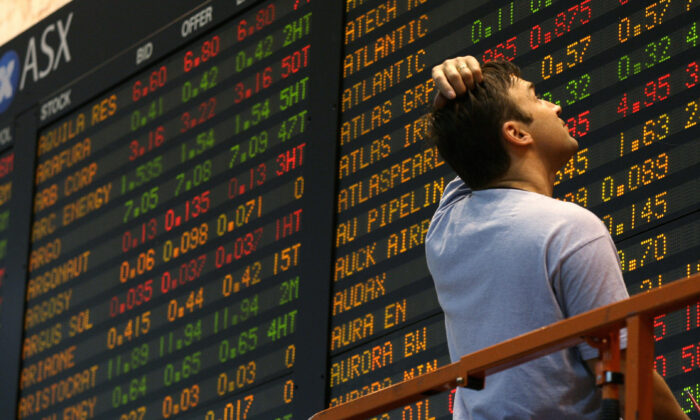The Australian share market and the Aussie dollar took a hit as global markets fretted over a potential second coronavirus wave, particularly in Europe, adding to the already unsettling backdrop of a US presidential election.
The S&P/ASX200 benchmark index closed 38.5 points down, or 0.7 percent, to 5784.1 on Sept. 22, but did manage to recover from a three month low of 5763.2 earlier in the day.
The All Ordinaries index fell 40 points, or 0.7 percent, to 5973.5, and also above a low of 5951.3.
The Aussie dollar sank to a one month low just below US$0.72 at one stage.
“After a treacherous start to the week, global markets are still in a slight state of fright,” IG Markets market analyst Kyle Rodda said.
The local market was down from the opening bell following a further decline on Wall Street, although the major indices there managed to recover earlier falls by the close.
Fears of a second wave of COVID-19 hit European markets on Sept. 21, and local investors followed the trend, regardless of Australia getting its own hotspot in Victoria under control.
Market heavyweights among the miners and banks were a sea of red.
BHP was down 1.8 percent at $36.67 and Rio Tinto was off 2.4 percent at $97.
Among the big four, Commonwealth was 0.7 percent lower at $63.07, ANZ fell 2.3 percent to $16.46, NAB was down 2.4 percent to $16.64 and Westpac declined 2.1 percent to $16.05.
There were some bright spots with retailers gaining ground as data showed consumer confidence— a pointer to future household spending—rose for a third straight week to stand at a three-month high.
Woolworths shares rose 1.8 percent to $36.85 and Wesfarmers were 1.5 percent higher at $44.38.
The Aussie dollar fell to a one-month low of US$0.7192 at one stage, before partially recovering to US$0.7209 at 4:15 p.m. AEST.
But that was still down from US$0.7314 at the close on Sept. 21.
The currency fall coincided with a speech by deputy Reserve Bank governor Guy Debelle, where he indicated lower interest rates are possible in Australia without going negative.
Debelle said the central bank had four policy options should the economy need a further boost.
These include extending its bond buying program to longer maturing issues, foreign exchange intervention and negative interest rates.
Another option is to lower the current structure of interest rates in the economy, both in terms of the target for government bond yields and the borrowing rate the RBA offers to banks from the current 0.25 percent.
“It is possible to further reduce these interest rates,” he said in his speech to the Australian Industry Group.
But he emphasised these were all just options.
Even so, National Australia Bank economists now see a “significant risk” of the Reserve Bank easing policy further by cutting the cash rate, 3-year yield target and the term funding facility rate to 0.10 percent from 0.25 percent.
Other data on Sept. 21 showed payroll jobs fell 0.7 percent for the month ending Sept. 5.
The Australian Bureau of Statistics said over this period jobs fell by 2.1 percent in locked-down Victoria and by 0.2 percent over the rest of the economy.
Payroll jobs remain about 4.5 percent lower than mid-March—8.3 percent lower in Victoria and 3.1 percent lower in the rest of Australia.
On the ASX
* The S&P/ASX200 benchmark index closed down 38.5 points, or 0.7 percent, at 5784.1 points on Sept. 22
* The All Ordinaries index finished 40 points lower, or 0.7 percent, at 5973.5
At 5:10 p.m. AEST, the SPI200 futures index was trading one point higher, or 0.02 percent, at 5772 points.
Currency Snapshot
One Australian dollar buys:
* US$0.7209, from US$0.7314 on Sept. 21
* 75.35 Japanese yen, from 76.31 yen
* 0.6132 Euros, from 61.67 cents
* 56.33 British pence, 56.52 pence
* NZ$1.0819, from NZ$1.0806
By Colin Brinsden, AAP Economics and Business Correspondent
Focus News: Australian Shares Hit by Global Worries
House Democrats Unveil Bill to Avert Government Shutdown, Lacks Farm Aid
